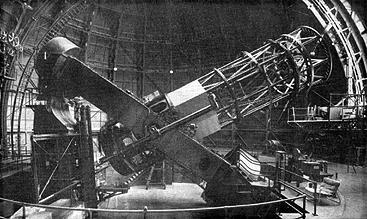
The Hooker Telescope on Mt. Wilson
Picture Credit: Mount Wilson Observatory
Discover the cosmos! Each day we feature a different image or photograph of our fascinating universe, along with a brief explanation written by a professional astronomer.
July 1, 1995

The Hooker Telescope on Mt. Wilson
Picture Credit: Mount Wilson Observatory
Explanation: In the 1920s, pictures from the Hooker Telescope on Mt. Wilson fundamentally changed our understanding of the cosmos. Astronomer Edwin Hubble, using photographs he took with this telescope, demonstrated that the objects his contemporaries called "spiral nebulae" were actually huge systems of stars - spiral galaxies, similar to our own Milky Way galaxy but incredibly distant. Prior to Hubble's work it was argued that the spiral nebulae were mere clouds of gas and that they, along with everything else in the universe, were contained in our own galaxy. The Hooker Telescope mirror is 100 inches in diameter which is nearly the size of the mirror of the orbiting Hubble Space Telescope named in Hubble's honor. The Mount Wilson Observatory offers a "virtual walking tour" of this historic telescope.
For more information see Mount Wilson Observatory Historical Image Archives